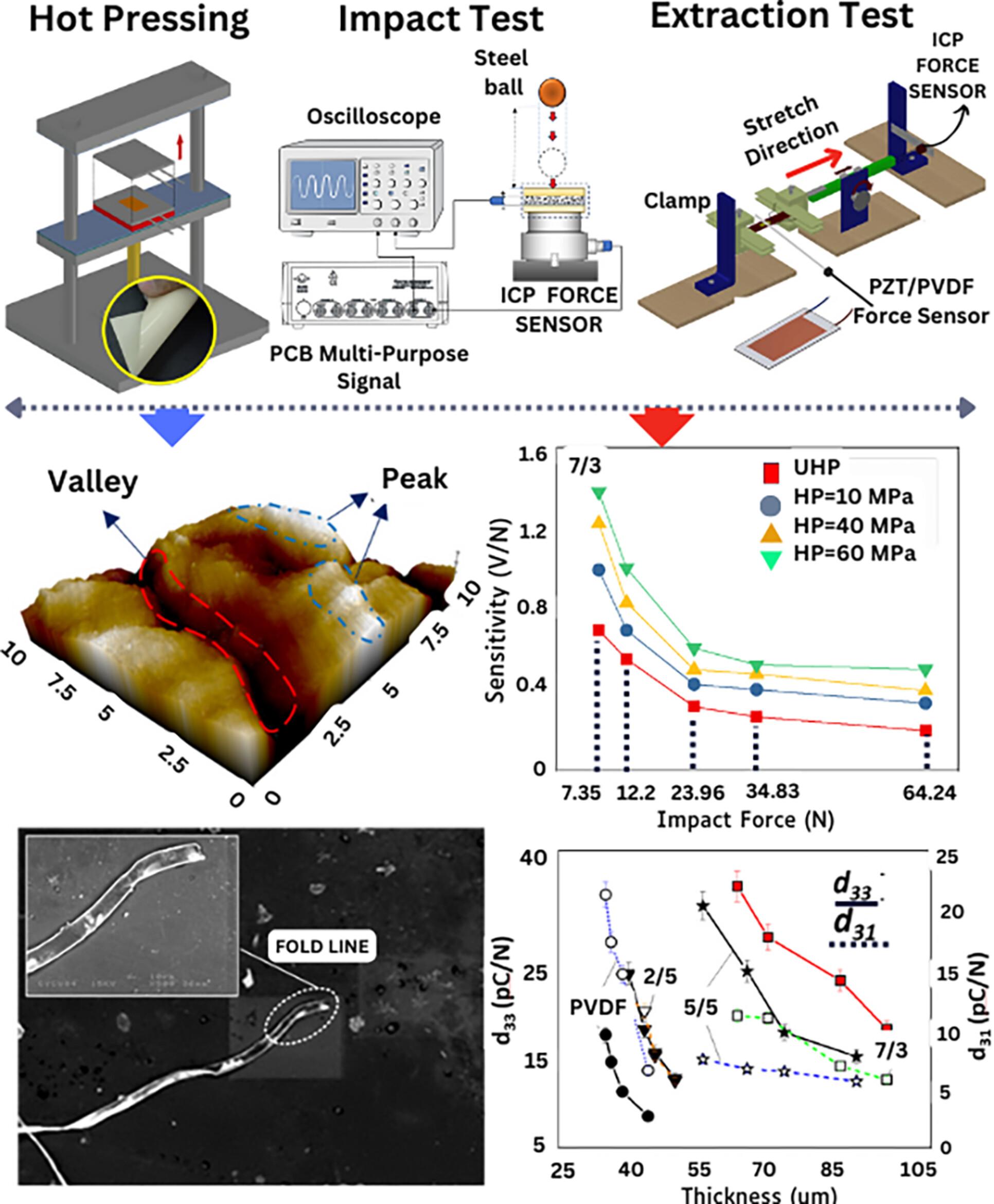Suprapto, Yung Ting, Hariyanto Gunawan, Edwar Yazid, Aditya Sukma Nugraha, Budi Azhari, M Luthfi Ramadiansyah, M Fathul Hikmawan, Jubaidah
求助PDF
{"title":"用于力传感器应用的 PZT/PVDF 复合薄膜的制作与表征","authors":"Suprapto, Yung Ting, Hariyanto Gunawan, Edwar Yazid, Aditya Sukma Nugraha, Budi Azhari, M Luthfi Ramadiansyah, M Fathul Hikmawan, Jubaidah","doi":"10.1002/pi.6643","DOIUrl":null,"url":null,"abstract":"<p>This study explored the impact of hot press parameters on lead zirconate titanate (PZT)/poly(vinylidene fluoride) (PVDF) composite films designed for force-sensing applications. The systematic fraction (PZT/PVDF), pressure, temperature, and time during hot pressing processes are subject to variation. The focus is on the resulting composite film thickness and its subsequent influence on the piezoelectric properties, which are essential for the performance of force sensors. The present study investigated the characteristics and performance of PZT/PVDF composite films with fraction ratios 2/5, 5/5, and 7/3 and hot pressure of 10, 40, and 60 MPa and temperature at 150 °C for 2 h. The characterization of these films was conducted using X-ray diffraction, Fourier transform infrared spectroscopy, atomic force microscopy, and scanning electron microscopy. The piezoelectric properties (<i>d</i><sub>33</sub> and <i>d</i><sub>31</sub>) were measured using impact and extraction tests to evaluate the performance of films with applied forces. The results show that the highest piezoelectric coefficients (<i>d</i><sub>33</sub> and <i>d</i><sub>31</sub>) were determined to be 35.8 and 12.60 pC N<sup>−1</sup>, with fraction ratios of 7/3 and 2/5. The study revealed a positive correlation between the PZT/PVDF ratio and sensitivity, indicating that an increase in the ratio leads to an increase in sensitivity. Conversely, a negative relationship was observed between the impact load and the sensor sensitivity, suggesting that an increase in the impact load results in a sensitivity decrease. The results of this work demonstrate the great potential of piezoelectric PZT/PVDF composite films in force sensors for small load applications. © 2024 Society of Chemical Industry.</p>","PeriodicalId":20404,"journal":{"name":"Polymer International","volume":"73 9","pages":"727-747"},"PeriodicalIF":3.6000,"publicationDate":"2024-04-24","publicationTypes":"Journal Article","fieldsOfStudy":null,"isOpenAccess":false,"openAccessPdf":"","citationCount":"0","resultStr":"{\"title\":\"Fabrication and characterization of PZT/PVDF composite films for force sensor applications\",\"authors\":\"Suprapto, Yung Ting, Hariyanto Gunawan, Edwar Yazid, Aditya Sukma Nugraha, Budi Azhari, M Luthfi Ramadiansyah, M Fathul Hikmawan, Jubaidah\",\"doi\":\"10.1002/pi.6643\",\"DOIUrl\":null,\"url\":null,\"abstract\":\"<p>This study explored the impact of hot press parameters on lead zirconate titanate (PZT)/poly(vinylidene fluoride) (PVDF) composite films designed for force-sensing applications. The systematic fraction (PZT/PVDF), pressure, temperature, and time during hot pressing processes are subject to variation. The focus is on the resulting composite film thickness and its subsequent influence on the piezoelectric properties, which are essential for the performance of force sensors. The present study investigated the characteristics and performance of PZT/PVDF composite films with fraction ratios 2/5, 5/5, and 7/3 and hot pressure of 10, 40, and 60 MPa and temperature at 150 °C for 2 h. The characterization of these films was conducted using X-ray diffraction, Fourier transform infrared spectroscopy, atomic force microscopy, and scanning electron microscopy. The piezoelectric properties (<i>d</i><sub>33</sub> and <i>d</i><sub>31</sub>) were measured using impact and extraction tests to evaluate the performance of films with applied forces. The results show that the highest piezoelectric coefficients (<i>d</i><sub>33</sub> and <i>d</i><sub>31</sub>) were determined to be 35.8 and 12.60 pC N<sup>−1</sup>, with fraction ratios of 7/3 and 2/5. The study revealed a positive correlation between the PZT/PVDF ratio and sensitivity, indicating that an increase in the ratio leads to an increase in sensitivity. Conversely, a negative relationship was observed between the impact load and the sensor sensitivity, suggesting that an increase in the impact load results in a sensitivity decrease. The results of this work demonstrate the great potential of piezoelectric PZT/PVDF composite films in force sensors for small load applications. © 2024 Society of Chemical Industry.</p>\",\"PeriodicalId\":20404,\"journal\":{\"name\":\"Polymer International\",\"volume\":\"73 9\",\"pages\":\"727-747\"},\"PeriodicalIF\":3.6000,\"publicationDate\":\"2024-04-24\",\"publicationTypes\":\"Journal Article\",\"fieldsOfStudy\":null,\"isOpenAccess\":false,\"openAccessPdf\":\"\",\"citationCount\":\"0\",\"resultStr\":null,\"platform\":\"Semanticscholar\",\"paperid\":null,\"PeriodicalName\":\"Polymer International\",\"FirstCategoryId\":\"92\",\"ListUrlMain\":\"https://onlinelibrary.wiley.com/doi/10.1002/pi.6643\",\"RegionNum\":4,\"RegionCategory\":\"化学\",\"ArticlePicture\":[],\"TitleCN\":null,\"AbstractTextCN\":null,\"PMCID\":null,\"EPubDate\":\"\",\"PubModel\":\"\",\"JCR\":\"Q2\",\"JCRName\":\"POLYMER SCIENCE\",\"Score\":null,\"Total\":0}","platform":"Semanticscholar","paperid":null,"PeriodicalName":"Polymer International","FirstCategoryId":"92","ListUrlMain":"https://onlinelibrary.wiley.com/doi/10.1002/pi.6643","RegionNum":4,"RegionCategory":"化学","ArticlePicture":[],"TitleCN":null,"AbstractTextCN":null,"PMCID":null,"EPubDate":"","PubModel":"","JCR":"Q2","JCRName":"POLYMER SCIENCE","Score":null,"Total":0}
引用次数: 0
引用
批量引用


 求助内容:
求助内容: 应助结果提醒方式:
应助结果提醒方式:


